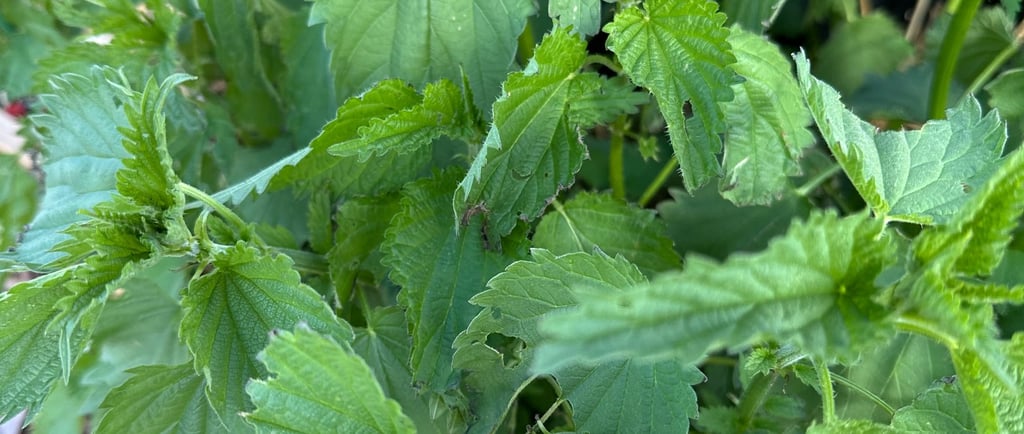The Medicinal Benefits of Catnip
When most people think of catnip, they imagine a euphoric cat rolling and purring in bliss. While catnip is well-known for its intoxicating effects on felines, this humble herb has a long history of medicinal use for humans. Native to Europe and parts of Asia but now widely naturalized across North America, catnip (Nepeta cataria) is a member of the mint family and has been used in traditional medicine for centuries.
5/17/20253 min read


When most people think of catnip, they imagine a euphoric cat rolling and purring in bliss. While catnip is well-known for its intoxicating effects on felines, this humble herb has a long history of medicinal use for humans. Native to Europe and parts of Asia but now widely naturalized across North America, catnip (Nepeta cataria) is a member of the mint family and has been used in traditional medicine for centuries.
In this blog post, we’ll explore the medicinal benefits of catnip, its common uses, and how you can incorporate this soothing herb into your wellness routine.
What Is Catnip?
Catnip is a perennial herb with soft, gray-green, heart-shaped leaves and small clusters of white to pale purple flowers. It contains a volatile oil called nepetalactone, which is responsible for its effects on cats—and many of its benefits for humans as well.
Historically, catnip has been used as a gentle herbal remedy, especially in European folk medicine, and it was even listed in the U.S. Pharmacopeia in the 19th century.
Key Medicinal Benefits of Catnip
1. Natural Sedative and Sleep Aid
Catnip is renowned for its calming effects. It has traditionally been used as a mild nervine—an herb that soothes the nervous system.
Benefit: Relieves anxiety, nervous tension, and promotes restful sleep.
How to Use: Drink as a tea before bed to ease insomnia and calm the mind.
2. Digestive Support
Catnip has antispasmodic properties, making it excellent for relieving gastrointestinal distress.
Benefit: Eases gas, bloating, indigestion, and colic—especially helpful for children.
How to Use: A warm cup of catnip tea can gently stimulate digestion and soothe an upset stomach.
3. Cold and Flu Remedy
As a diaphoretic, catnip encourages perspiration, which can help break a fever during colds or flu. It also has mild antimicrobial and anti-inflammatory properties.
Benefit: Reduces fever, soothes sore throats, relieves nasal congestion, and eases coughing.
How to Use: Brew catnip tea with honey and lemon for a gentle remedy during illness.
4. Menstrual and Muscle Cramp Relief
Catnip’s muscle-relaxing properties extend to uterine muscles, making it useful for easing menstrual discomfort.
Benefit: Alleviates menstrual cramps and general muscle tension.
How to Use: Sip tea during your cycle or use in combination with other relaxing herbs like chamomile or lemon balm.
5. Anti-inflammatory and Pain Relief
Applied topically or taken internally, catnip may reduce inflammation and relieve minor aches and pains.
Benefit: Soothes minor cuts, bug bites, and joint pain.
How to Use: Create a poultice or infused oil for topical use.
How to Use Catnip Medicinally
1. Catnip Tea
One of the most popular methods. Use 1–2 teaspoons of dried catnip leaves and flowers per cup of boiling water. Steep for 10–15 minutes. Drink up to three times daily.
2. Tincture
A catnip tincture can be taken in small doses (usually 10–30 drops) for calming effects or digestive issues.
3. Poultice or Compress
Crushed fresh catnip leaves can be applied directly to the skin to soothe inflammation, swelling, or insect bites.
4. Bath Soak
Add dried catnip to a muslin bag or tea infuser and steep it in your bath for a calming soak.
Cautions and Considerations
Catnip is considered safe for most people, including children, when used in moderation.
Avoid during pregnancy in large doses due to its potential to stimulate uterine contractions.
As with any herb, consult your healthcare provider if you are taking medications or have underlying conditions.
Growing Catnip in Your Garden
Catnip is easy to grow in most climates and thrives in full sun with well-drained soil. It can be grown in containers or garden beds, and pollinators love its blooms. Harvest the leaves and flowers before the plant goes to seed for the most potent medicinal use.
Final Thoughts
Catnip is a gentle yet powerful herbal ally that deserves a place in every healing garden. Beyond its playful effect on cats, it offers humans a natural way to relax, ease discomfort, and support overall wellness. Whether you sip it in a calming tea or grow it to enrich your herbal apothecary, catnip is a soothing gift from nature worth rediscovering.
🌿 Healing IN Garden Tip: Try blending catnip with calming herbs like chamomile, lemon balm, or skullcap for a relaxing evening tea.
Grow
Cultivating wellness through gardening and sustainability.
Email Us:
© 2025. Healing IN Garden & Farm LLC. All rights reserved.
Created by askdolo.com
